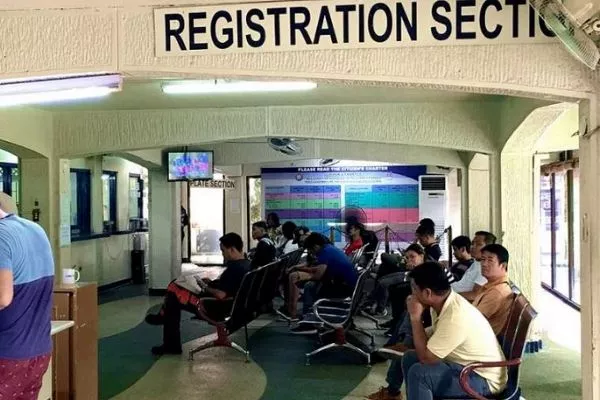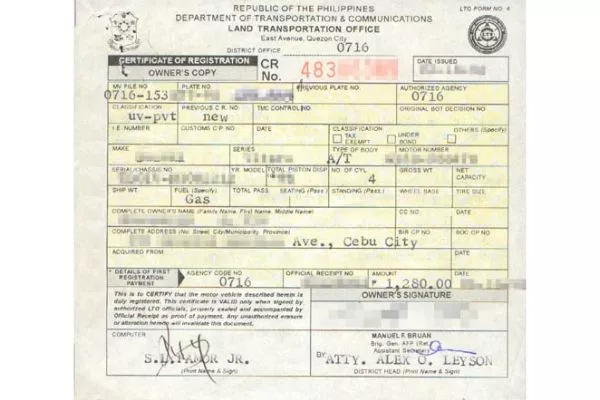A guide to OR/CR: Introduction
Purchasing a car can be a daunting task for first-time buyers; there are many unfamiliar terms that pop up one after another, and it can be taxing to remember them all.
Some of the things you'll have to keep in mind are car specifications, financing details, maintenance regimen and warranty claims, different kinds of car insurance, and of course, the official receipt and the certificate of registration, which the Land Transportation Office (LTO) abbreviates as the OR/CR.

Apart from daunting, going to an LTO branch is also typically a very boring experience with lots of waiting involved.
Driving newbies may neglect to ask what those letters refer to, despite the fact that they’re the two most important pieces of paper relating to your car. Shy, perhaps?
So what exactly is OR CR meaning? Worry not, because Philkotse.com is here to help with a comprehensive explanation of these two terms, along with an OR/CR sample.
1. What does OR/CR mean?
The LTO issued OR/CR are the two most important documents where you car is concerned. These two identifies and distinguishes your car from every other car in the Philippines, even if they happen to be exactly the same model, variant, or body color. Think of them as a unique ID for your car.
A vehicle is typically identified by its designated OR, engine and chassis number, and this information is indicated in the OR and CR.
OR or Official Receipt
The LTO Official Receipt, more commonly known as the OR refers to the document issued by the Land Transportation Office. As the name suggests, this is a receipt serving as proof that the owner has paid for the vehicle's registration.

An LTO-issued Official Receipt or OR
As you can see from the OR sample above, it has a background composed of sky blue LTO logos, and it contains important information about the car. These includes the name of the person who paid for the vehicle’s registration fees (Received from), where the payee is from (Address), the vehicle's license plate number, and a summary of the fees paid for, and of course, the date when the transaction was made.
The OR also carries its own unique serial number, called an OR number, of which CANNOT be changed or altered in any way.
>>> Also read: Everything you need to know about driver’s license restrictions
CR or Certificate of Registration
The other half of a car's registration documents is the Certificate of Registration LTO, commonly referred to as the CR. The the OR, this particular document is also issued by the LTO.
The CR contains more technical information about a particular vehicle. This includes its make, model, vehicle class, motor number, chassis number, engine displacement, number of cylinders, gross weight, net capacity, total number of passengers, as well as the owner's complete name and address. As to how it looks like, remember that the OR has a primarily blue background. The CR however has predominantly yellow color.

An LTO-issued Certificate of Registration or CR
>>> Worth your note: Car Registration LTO Ultimate Guide: Requirements, Fee, Schedule & More
2. What if I lost my OR/CR?
If it isn’t obvious by now, you should always keep a copy of your car’s OR/CR in your car. But if you’re paranoid like us, we highly advise you to keep several copies stored in multiple locations, such as your home, the office and your car, in case you misplaced the original copy of either of of the two.
For the original copies, we recommend having them laminated to protect them from damage, and store them in a secure location in your home, preferably in a safe together with your other valuable documents.
But what happens if you lose your OR/CR?
For one thing, you car won't be allowed on public roads using the said car, since you won't have documentary proof that the car can be legally driven. You also won’t be able to renew its registration. And lastly, if you’re planning to sell your car, a missing Official receipt LTO (OR) is considered a red flag and will place you under suspicion, except maybe if the buyer intends to turn your car into scrap or strip it for parts.
Having a lost OR/CR is a pretty crappy situation overall. So how do you fix it? You can actually get a copy from the LTO because they keep their own copies of your car’s OR/CR anyway. But you can’t do this at any LTO branch though; you’ll have to go to the LTO branch where the car was first registered, since this is where all the necessary documents relating to you are stored.
Here are the steps to securing a duplicate copy of your OR/CR:
- First off, get a duly notarized affidavit of loss. If you’re not the owner, secure this from the registered owner
- Second, find the most recent official receipt of payment of registration
- Third, secure a duly accomplished and approved Motor Vehicle Inspection Report or MVIR
- Fourth, present two valid identification cards, preferably government issued.
3. What should I do if I still haven’t received my car’s OR/CR?
According to the LTO, you can use your brand-new car on public roads for seven days, beginning from the date indicated on the car’s sales invoice based on the vehicle’s issued conduction sticker.
After that seven-day grace period, your new car should have a Certificate of Registration LTO or CR from the LTO to be used legally on public roads. You can expect most car dealers to comply by providing you with this document document for your car. If not, you can proceed to file an action to demand, which will hopefully make the dealer comply in a reasonable amount of time. If the document is still not in your possession by this time, you can actually file a complaint against a dealer, as failure to provide a CR violates the Consumer Protection Act.
Fortunately, the LTO has stopped apprehending new vehicles travelling without license plates due to a shortage in supply, but you should still present a car’s OR and CR when asked, as well as install a temporary plate number in the Philippines.

If a license plate is not yet available, a temporary plate will do. Also, don't forget a copy of your car's OR and CR
As for the No OR/CR, No Travel policy update 2019, the seven-day grace period beginning from the date indicated on the sales invoice is still in effect.
LTO OR/CR: Checking for availability
As mentioned above, a dealership should provide that car's LTO issued OR and CR seven days after the sale. Realistically however, there will be some issues where you will have to wait longer. So how does one check for if the LTO issued OR/CR is already available?
Well, this falls on you, the car buyer, to follow up ever so often with the dealership. To this end, we highly advice people who have recently bought brand new cars to contact their dealerships even before the seven-day grace period expires.
In the case of some motorcycle dealerships though, they have come up with checking for a unit's OR/CR via social media. We won't name which dealer, but its certainly a more convencient way than consistently ringing and calling up your sales person. Speaking of car sales people, most will be diligent enough to contact you once your car's OR/CR is available.
Visit Philkotse.com for more tips and advice.
Recent posts
- Car registration renewal in the Philippines: Everything you need to know Aug 22, 2022
- Ultimate guide on how to fill up the LTO ADL form (LTO Driver's license Application form) Aug 24, 2021
- Lost plate number LTO Philippines: Step-by-step guide with Affidavit of loss LTO sample Sep 16, 2021
- Temporary Plate Number Philippines: LTO guidelines and other helpful tips Apr 10, 2023
- Renewal of LTO driver's license: The Ultimate guide for Filipino Drivers Oct 20, 2021












